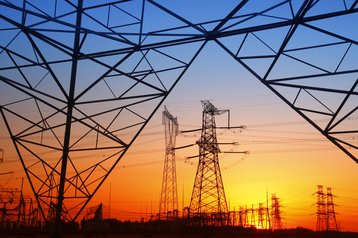We all know that the UK energy market is going through a period of transformation, as we balance the need to secure reliable energy supplies with reducing carbon emissions and maintaining affordability.
In the next few decades the change in make-up of power generation will accelerate as we move away from a small number of centralised power stations to a more varied mix of renewables, nuclear and traditional fuels. This all poses a challenge to energy suppliers and the grid as balancing capacity becomes ever harder - a subject that is receiving high-profile media coverage.
Benefitting from change
In addition, around half of the electricity bill is now made up of non-commodity costs. So costs such as network and transmission charges, along with other levies, are putting pressure on energy bills.
What sometimes isn’t clear is how this changing situation can be seen as a commercial opportunity. Tackling the energy-related issues that data center owners face – such as improving the resilience of their sites and increasing the capacity of their grid connection – could now actually result in additional revenue as well.
So in addition to navigating energy contracts, energy efficiency measures and regulatory change such as the closure in 2019 of the Carbon Reduction Commitment (CRC), data center managers with a responsibility for energy should start to look at their energy strategy as an opportunity to turn a cost into a revenue opportunity.
Removing cost from your energy bill
One of the simplest ways to remove cost from your bill is to use less energy provided by the grid and generate more onsite using the right renewable technologies for the building.
Many suppliers also talk about the financial payments available for being both ready to reduce non-essential energy demand and able to participate in ‘dispatches’ where the Grid pays you to reduce demand when needed. This could also provide savings on your energy tariff rate, which is achieved by reducing your need for peak-price energy in the red rate banding and at the triads.
By participating in a demand response programme, your use at peak times could decrease. Savings here could lead to significant financial benefits beyond the capacity payments offered by demand response scheme providers.
Using your back-up generation assets to create revenue
When it comes to the energy needs of large data centers, companies are most interested in the resilience of their sites. This is particularly important for those who have uninterruptible power supplies.
These businesses can over-compensate for their needs with back-up generation to protect themselves from grid outages. This makes sound business sense, but traditionally these generators have used diesel as their main fuel.
While being readily available, using these assets can hurt a company’s carbon emissions and cost a considerable amount due to their lack of efficiency. This is before considering their on-going maintenance given that they may not be used very often, if at all, during their lifespan.
What companies may not realise is that the market is moving on and they could be more proactive with these assets:
New business models are emerging that allow generators to become highly flexible power plants that can be embedded into the local distribution networks and operate as ‘peaking plants’.
This means that they are be able to step in to support security of supply at periods of high demand. Network operators recognise the benefits of this and are incentivising generators who are able to provide this additional power when it’s needed most.
Enhancing site resilience through energy storage
Energy storage could give data centers an opportunity to take advantage of lower prices at times when demand is lower, such as at weekends and overnight. Power could be taken off the grid and stored for use at a later time.
The economics of using batteries to store energy in large volumes is starting to look more favourable. Combining them with renewable energy assets such as solar and wind could also result in a decreased payback period and the improved efficiency of these investments.
Increasing site capacity to fuel growth
Data centers can struggle to increase the size of their grid connection to their building to allow them to grow their business. If they are granted increased capacity, it can be extremely costly. Energy efficiency can be used as a way to create a gap under the maximum building capacity to add in more infrastructure, but there is always likely to be a ceiling.
By installing a CHP generator one data provider we worked with doubled the amount of capacity on a site that otherwise had no opportunity for expansion, meaning they could expand their business and stay at their current site. The business case for investment became very attractive to the company as they could benefit from lower energy bills and boost their capacity to service more clients.
Of course, CHP is not an appropriate technology for everyone given its output has to be converted into cooling. So at this point it’s worth considering how data centers can procure the most effective technologies for them. This is where the distributed energy model comes into play.
Tying it all together: The distributed energy model
It’s clear that new perspectives on energy use and generation pose a real commercial opportunity for data center energy managers. But this opportunity could create an unnecessarily complex environment that could be difficult to optimise.
This issue has led to the rise in the distributed energy business model. British Gas’ parent company Centrica has committed £700m by 2020 to create a global business that offers businesses the chance to harness this new marketplace in a simple and integrated way.
It’s a world where smaller independent generation sites join forces with battery storage, energy efficiency and smart building management systems, typically managed from a single energy control center.
Unlike the old model of customers simply receiving the energy from suppliers, distributed energy provides consumers with wider choice and greater control over their energy.
They will have control over their own energy demand, where and when they generate their power and how they can use the grid as a way of generating income.
For example by avoiding a combination of higher winter peaking tariffs, making assets available to provide energy to the grid and savings on the Carbon Reduction Commitment (CRC), net benefits after costs can be in the tens of thousands of pounds per megawatt per year.
And of course, to receive a discount on the Climate Change Levy (CCL) many data centers have applied for an exemption in the shape of a Climate Change Agreement (CCA). These are voluntary agreements made between UK industry and the Environment Agency to reduce energy use and carbon dioxide (CO2) emissions.
The PUE or Power Effectiveness Score helps drive this forward – and centers need to get this close to a figure of 1. As the CRC is being scrapped in 2019, this may encourage more businesses to seek a CCA and encourage them to improve their power usage effectiveness. Adopting a distributed energy model could help businesses to meet the terms of their CCA and avoid the risk of having to pay back the discount they were given on the CCL.
There is no one business case that fits every data business, so distributed energy models are allowing businesses to create bespoke energy infrastructure to suit their needs.
With these new opportunities, the innovative data center energy manager can begin to change their perspective about the national energy grid from a primary provider of power to a back-up facility should their own generation not fully support their needs.
If you’d like to find out more about our new distributed energy business or how to take advantage of some of the schemes I’ve discussed in this article, please feel free to get in touch.
Mike Chessum is director of industrial and commercial business sales at British Gas


